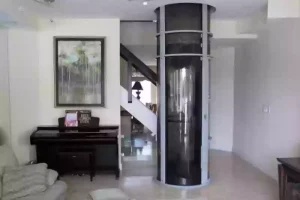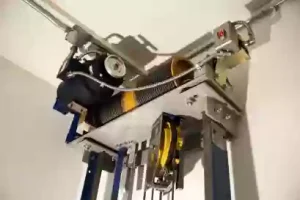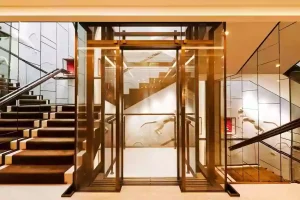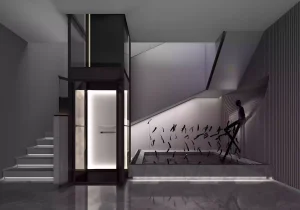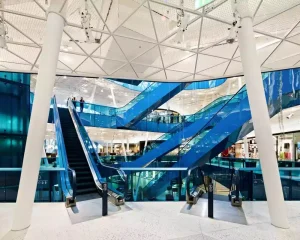If you’re planning to add an elevator to your house, you’ll want to know the differences between the options. Here’s the lowdown on the top four types of residential elevators.
Residential Elevator Types Quick Overview
| Residential Elevator Type | Hydraulic Elevator | Traction Elevator | Vacuum Elevator | Shaftless Elevator | Machine Room-Less (MRL) Elevator |
|---|---|---|---|---|---|
| Features | Hydraulic drive, smooth operation, easy maintenance | Steel rope drive, fast speed, energy efficient | Air pressure drive, compact design, no machine room | Guide rail drive, quick installation, small footprint | Traction drive, no machine room, energy efficient |
| Completion Time | 4-6 weeks | 6-10 weeks | 3-5 weeks | 2-4 weeks | 5-8 weeks |
| Purchase Cost | $30,000 – $50,000 | $50,000 – $100,000 | $40,000 – $70,000 | $15,000 – $25,000 | $40,000 – $80,000 |
| Max Distance | 15-20m | 60-100m | 12-15m | 4-6m | 20-30m |
| Max Speed | 0.63 m/s | 1.0-4.0 m/s | 0.15-0.3 m/s | 0.15 m/s | 1.0-2.0 m/s |
| Capacity | 1000-2000 kg | 1000-2500 kg | 150-250 kg | 200-400 kg | 1000-1600 kg |
| Suitable Buildings | Low-rise residential buildings, shops, hospitals | High-rise apartments, office buildings, shopping malls | Villas, duplex apartments, private residences | Old residential buildings, duplex homes, low-rise shops | Mid to high-rise residential buildings, office buildings, hotels |
A detailed introduction to the main types of residential elevators
Hydraulic Elevators
Hydraulic elevators use a hydraulic pump to push a piston, causing the cabin to move up or down. They operate smoothly and quietly, making them especially suitable for low-rise residential buildings, villas, and hospitals. The main advantages are low installation cost and easy maintenance, but due to their relatively slow speed, they are typically used in buildings with 1 to 10 floors.
Hydraulic Elevator Quick Preview Table
| Type | Maximum Load | Maximum Speed (per minute) | Safety | Suitable for |
|---|---|---|---|---|
| Traditional Hydraulic Elevator | 1000kg | 0.63 m/s | Good stability, low maintenance cost | Low-rise residential, villas, hospitals |
| Roped Hydraulic Elevator | 1500kg | 1.0 m/s | Complex structure, space-saving | Commercial buildings, duplex apartments |
| Holeless Hydraulic Elevator | 2000kg | 0.75 m/s | High safety, no pit structure | Underground garages, low-rise buildings |
1. Traditional Hydraulic Elevator
This type of elevator uses a hydraulic pump to drive a piston, with a pulley installed at the bottom pit. As the piston moves up and down, it lifts or lowers the cabin. The advantages include stable operation and low noise, making it particularly suitable for low-rise residential buildings.
2. Roped Hydraulic Elevator
Roped hydraulic elevators combine hydraulic systems and steel rope transmission, reducing shaft space occupancy and allowing for greater lift heights compared to traditional hydraulic elevators. They are ideal for duplex apartments and small commercial buildings.
3. Holeless Hydraulic Elevator
Holeless hydraulic elevators do not require a deep pit, utilizing a short-cylinder hydraulic system. They are especially suitable for underground garages and retrofitting old buildings.
Traction Elevators
Traction elevators move the cabin up and down by pulling with a traction machine and steel cables. They offer the advantages of high speed and low energy consumption and are widely used in mid to high-rise residential buildings and commercial structures such as apartments, office buildings, and shopping centers. Due to the high efficiency of the traction system, they are the preferred choice for modern high-rise buildings.
Traction Elevator Quick Preview Table
| Type | Maximum Load | Maximum Speed (per minute) | Safety | Suitable for |
|---|---|---|---|---|
| Geared Traction Elevator | 1600kg | 2.0 m/s | Stable, high energy consumption | Mid to high-rise residential, office buildings |
| Gearless Traction Elevator | 2000kg | 4.0 m/s | Energy-saving, low noise | High-rise apartments, office towers |
| MMR Elevator | 1000kg | 1.5 m/s | No machine room, space-saving | Duplex apartments, hotels |
1. Geared Traction Elevator
Geared traction elevators use a gearbox to drive the traction machine, providing strong power, making them suitable for high-rise buildings. At the Burj Khalifa in Dubai, a KONE geared traction elevator operates at a speed of 4m/s, reducing energy consumption by 15% compared to traditional elevators, thereby enhancing passenger transport efficiency.
2. Gearless Traction Elevator
This type uses direct drive technology, eliminating the gearbox to reduce energy consumption and noise. It is ideal for high-rise apartments and office buildings.
3. MMR Elevator (Machine Room Reduced)
MMR elevators integrate the drive system into the top of the shaft, eliminating the need for a separate machine room and saving space, making them suitable for mid to low-rise commercial buildings and hotels.
Pneumatic Elevators
Pneumatic elevators operate by using air pressure differences to move the cabin up and down. They are characterized by a simple structure and small footprint, making them especially suitable for duplex houses and private villas. These elevators are quick to install and usually do not require a dedicated shaft or machine room.
Pneumatic Elevator Types and Specifications
| Type | Maximum Load | Maximum Speed (per minute) | Safety | Suitable for |
|---|---|---|---|---|
| Single-Tube Pneumatic Elevator | 250kg | 0.3 m/s | Moderate, slow operation | Private residences, villas |
| Double-Tube Pneumatic Elevator | 400kg | 0.5 m/s | Stable, high space utilization | Duplex apartments, attics |
1. Single-Tube Pneumatic Elevator
Single-tube pneumatic elevators use single-cylinder air drive, suitable for space-limited residential buildings.
2. Double-Tube Pneumatic Elevator
Double-tube pneumatic elevators use dual-cylinder coordination, offering faster lifting speeds and are suitable for duplex apartments and narrow staircases.
Shaftless Elevators
Shaftless elevators do not require a traditional shaft, greatly reducing installation difficulty, making them ideal for retrofitting older residential buildings and space-limited structures. Their compact structure and high flexibility make them commonly used in small commercial buildings and duplex apartments.
Advantages: No need for large civil construction, short construction cycle, low cost.
Limitations: Limited lifting height, not suitable for high-rise buildings.
Shaftless Elevator Types and Specifications
| Type | Maximum Load | Maximum Speed (per minute) | Safety | Suitable for |
|---|---|---|---|---|
| Linear Shaftless Elevator | 400kg | 0.3 m/s | High safety, stable operation | Two-story residential, low-rise commercial buildings |
| Flat Shaftless Elevator | 300kg | 0.25 m/s | Fast installation, simple structure | Old building renovations, small shops |
1. Linear Shaftless Elevator
This type uses direct guide rail lifting, with the equipment installed directly on the wall or next to stairs, suitable for low-rise, space-limited residences. At a historic building in Berlin’s city center, a BDFUJI linear shaftless elevator was installed without compromising the building structure.
2. Flat Shaftless Elevator
The flat shaftless elevator combines horizontal drive and vertical lift, minimizing building alterations during installation. In a London commercial renovation project, a KONE flat shaftless elevator was installed, occupying just 1.5 square meters, significantly modernizing the old building.
MRL Elevators (Machine Room-Less)
MRL elevators integrate the drive system at the top of the shaft, eliminating the need for a separate machine room, which saves space and construction costs. They are widely used in mid to high-rise residential buildings and office buildings.
MRL Elevator Types and Specifications
| Type | Maximum Load | Maximum Speed (per minute) | Safety | Suitable for |
|---|---|---|---|---|
| Standard MRL Elevator | 1000kg | 1.5 m/s | Safe and stable, easy maintenance | Mid to high-rise residential, office buildings |
| Compact MRL Elevator | 800kg | 1.0 m/s | High space efficiency, eco-friendly | Duplex apartments, small commercial buildings |
1. Standard MRL Elevator
This type of elevator integrates the traction machine and control cabinet at the top of the shaft, requiring no additional space. It is suitable for residential and office buildings up to 15 floors. In a modern apartment in Sydney, an OTIS standard MRL elevator was installed, saving 20% of machine room space.
2. Compact MRL Elevator
Mainly used in space-constrained or small residential buildings, the compact MRL elevator features a small drive unit, resulting in better noise control. In a shop in Osaka, Japan, a Schindler compact MRL elevator was installed, providing smooth operation and receiving positive feedback from tenants.
Special Types of Residential Elevators
Apart from the five main types mentioned earlier, there are also some special types of residential elevators on the market, designed for specific needs and unique scenarios.
Pitless Elevator
The pitless elevator does not require deep pit excavation, making it ideal for projects with foundation constraints or renovations of old buildings and private residences.

Pitless Elevator Quick Preview Table
| Parameter | Specification |
|---|---|
| Maximum Load | 400kg |
| Maximum Speed | 0.3 m/s |
| Safety | Quick installation, stable structure |
| Suitable for | Buildings with foundation limitations, old buildings, private residences |
Drum Elevator
Drum elevators use a drum traction mechanism, characterized by a compact structure, making them widely used in small residential buildings and attic renovations.
Drum Elevator Quick Preview Table
| Parameter | Specification |
|---|---|
| Maximum Load | 300kg |
| Maximum Speed | 0.4 m/s |
| Safety | Emergency braking protection |
| Suitable for | Villas, duplex apartments |
Glass Elevator
Glass elevators use transparent glass cabins and guide rails, featuring a modern and aesthetic design. They are mainly used in high-end residential buildings and scenic architectures.
Glass Elevator Quick Preview Table
| Parameter | Specification |
|---|---|
| Maximum Load | 600kg |
| Maximum Speed | 1.0 m/s |
| Safety | Anti-fall protection, emergency lighting |
| Suitable for | Luxury villas, commercial clubs |
How to Choose the Right Residential Elevator?
After reading the detailed information on residential elevator types, you probably have a clearer understanding of their differences. But how can you determine which elevator is the best fit for your home? Consider these four key factors:
1. Purpose
The primary factor in choosing an elevator is its intended purpose, as different building types require different elevator configurations:
| Building Type | Suitable Elevators | Reason |
|---|---|---|
| Low-Rise Residential Buildings (1-5 floors) | Hydraulic Elevators or Pneumatic Elevators (air-driven) | Flexible installation, lower cost |
| Mid to High-Rise Residential Buildings (6-20 floors) | Traction Elevators or Machine Room-Less Elevators (MRL) | Low energy consumption, stable operation |
| High-Rise and Super High-Rise Buildings (20+ floors) | Traction Elevators | High speed and large load capacity |
| Special Purposes (Villas, Duplex Apartments) | Pneumatic Elevators and Shaftless Elevators | Compact structure, no machine room or pit required |
2. Budget
The budget for an elevator not only includes the purchase cost but also factors in installation, maintenance, and energy consumption.
| Elevator Type | Purchase Cost | Installation Cost | Maintenance Cost | Recommended for | Cost-Effectiveness |
|---|---|---|---|---|---|
| Hydraulic Elevators | $15,000 – $40,000 | Medium, requires pit and machine room | Low, regular lubrication and inspection | Low-rise residential buildings, villas | High, especially in low-rise buildings |
| Traction Elevators | $25,000 – $70,000 | High, needs a dedicated machine room and complex wiring | Medium, regular replacement of traction wheels and cables | Mid to high-rise buildings, commercial premises | High, ideal for buildings over 20 floors |
| Pneumatic Elevators | $20,000 – $50,000 | Low, no pit or machine room required | Low, periodic air pressure system checks | Villas, duplex apartments | Medium, easy installation but slower speed |
Brand Comparison:
| Data | BDFUJI | OTIS | KONE |
|---|---|---|---|
| Cost-Effectiveness | High cost-effectiveness | Premium brand | High-end pricing |
| Suitable Projects | Medium to low-budget residential projects | High-rise commercial buildings | High-end apartments |
| Market Popularity | Popular in Middle East, South America, and Southeast Asia | Widely used in commercial buildings globally | Known for luxury and comfort-focused markets |
| Key Features | Many successful projects, positive reviews | Remote monitoring, intelligent energy-saving features | Energy efficiency, noise reduction, ideal for comfort and quiet |
3. Installation Space
Different types of elevators have various space requirements. Some require a pit or additional machine room, so it’s important to assess your building conditions before choosing.
| Elevator Type | Space Requirement | Suitable Buildings | Advantages |
|---|---|---|---|
| Machine Room-Less Elevator (MRL) | Traction machine integrated at the top of the shaft, saving machine room space | Modern residential buildings, apartment complexes | Space-saving, energy-efficient |
| Shaftless Elevator | No fixed shaft required, high flexibility | Old building renovations, duplex villas | Quick installation, minimal structural modification |
4. Safety
Safety is a critical consideration when installing a residential elevator. Always choose brands with emergency braking, power failure protection, and dual door lock features.
| Elevator Type | Safety Features |
|---|---|
| Hydraulic Elevators | Pit design to absorb impact, high stability |
| Traction Elevators | Dual braking system to prevent accidental descent |
| Pneumatic Elevators | Air-lock mechanism to prevent sudden falls |
Average Costs of Residential Elevators by Type
The cost of a residential elevator is a major deciding factor. It typically includes purchase cost, installation cost, and maintenance expenses. The cost varies significantly based on the type of elevator, so it’s important to budget accordingly.
Cost Breakdown:
| Elevator Type | Purchase Cost | Installation Cost | Maintenance Cost | Total Cost (20 years) |
|---|---|---|---|---|
| Hydraulic Elevator | $15,000 – $40,000 | $5,000 – $10,000 | $1,000 – $2,000/year | $40,000 – $80,000 |
| Traction Elevator | $25,000 – $70,000 | $8,000 – $15,000 | $1,500 – $3,000/year | $60,000 – $120,000 |
| Pneumatic Elevator | $20,000 – $50,000 | $4,000 – $8,000 | $800 – $1,500/year | $35,000 – $75,000 |
| Shaftless Elevator | $10,000 – $30,000 | $3,000 – $5,000 | $600 – $1,200/year | $25,000 – $55,000 |
| Machine Room-Less (MRL) | $30,000 – $60,000 | $6,000 – $12,000 | $1,200 – $2,500/year | $50,000 – $100,000 |
To learn more about residential elevator prices, please read: What will be the price of home elevators in 2025? The most complete cost analysis + money-saving tips
Brand Recommendations:
-
BDFUJI: High cost-effectiveness, suitable for medium to low-budget projects, with relatively low purchase costs.
-
OTIS: Ideal for high-end residential and commercial applications, offering smart energy-saving control with lower long-term operating costs.

How Much Space Does a Residential Elevator Require?
The space required for a residential elevator typically depends on four factors: cabin size, shaft space, pit depth, and top clearance. Choosing the right type of elevator requires careful planning based on the available building space.
| Factor | Specification | Standard Residential Elevator | Compact Elevator | Machine Room-Less Elevator (MRL) |
|---|---|---|---|---|
| Cabin Size | Width | 1000-1400mm | 900-1100mm | |
| Depth | 1200-1600mm | 1000-1300mm | ||
| Height | 2100mm | 2000mm | ||
| Shaft Space | Shaft Width | 1500-2000mm | 1600-2000mm | |
| Shaft Depth | 1500-1800mm | 1600-2000mm | ||
| Pit and Top Space | Pit Depth | 1000-1500mm | ||
| Top Clearance | 2500-3500mm |
Residential Elevators FAQ
Are Pneumatic Elevators Safe for Residential Use?
Yes, pneumatic elevators are very safe for residential use. They move up and down using air pressure and have features to protect against air loss and to prevent sudden drops. If there is a power outage, the elevator will slowly descend to the ground, preventing any sudden falls and keeping you safe.
Which Brands Offer Residential Elevators for Wheelchair Users?
Schindler and BDFUJI are leading brands that design residential elevators for wheelchair users. Schindler elevators have low platforms and wide doors, while BDFUJI goes a step further by offering smart control systems that can be operated through a smartphone app, making it easier for wheelchair users to enter and exit the elevator.
What Is the Best Type of Residential Elevator?
Considering comfort, safety, and cost, hydraulic elevators are ideal for low-rise buildings, traction elevators are better for high-rise constructions, and pneumatic elevators are perfect for private residences with limited space.
In summary: Residential elevators are more than just a luxury—they make life easier. Whether you choose hydraulic, pneumatic, or traction, each type has its own benefits (and its own challenges). So, pick your elevator like you’re choosing your next Netflix marathon—carefully, with lots of research.

